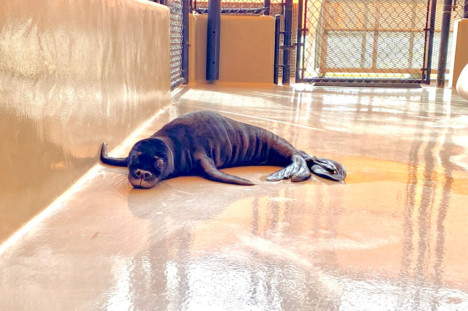Molokai Monk Seal Pup Recovering on Big Island

Pup RU99 is receiving life-saving care at The Marine Mammal Center’s Hawaiian monk seal hospital, Ke Kai Ola, on Hawaii Island. Photo courtesy of the Marine Mammal Center (NOAA Fisheries Permit #24359)
By The Molokai Dispatch staff
This has been another “banner year” for monk seal pupping in the main Hawaiian Islands, with 35 new pups so far, as reported by the National Oceanic and Atmospheric Administration in a recent news release. As the peak pupping season winds down, most of these new pups are thriving and exploring the reefs on their own.
However, two small pups, one on Molokai and another on Kauai, needed extra help. Due to quick action by NOAA’s team and partners, both are now receiving life-saving care at the Marine Mammal Center’s Hawaiian monk seal hospital, Ke Kai Ola, in Kona, Big Island.
Pup RU99 was first reported alone with no mother in sight, on the eastern shoreline of Molokai, resting on rock formations near the ocean. NOAA estimates the male pup was almost two-weeks old.
“It’s crucial that Hawaiian monk seal mothers stay with their pups the entire 5-7 week nursing period. Our partners monitored RU99 to see if the mother seal would return. When she did not, we determined a rescue was the pup’s best chance at survival,” NOAA officials said in the release.
With NOAA’s coordination, their partners on the ground collected RU99 for transport to Ke Kai Ola. The pup is responding positively to care and continuing to grow and develop, according to NOAA.
“We may never know who RU99’s mother is, or why the two separated, but thankfully due to quick reporting and response, the pup has a new outlook on life,” NOAA said.
Additionally, well-known survivor RH38 gave birth to her first pup, RU28, on Kauai this summer.
“Watching RH38 join the ranks of motherhood was a special experience for everyone involved in the mother seal’s historical care at the center. The pair spent nearly 5 weeks together during the 5-7 week nursing period,” NOAA said.
After weaning, NOAA assessed RU28 and determined the pup was underweight and unlikely to survive without intervention. Weight is important because pups rely on their reserves as they learn to feed themselves, according to NOAA officials. They worked with partners to transport RU28 to Ke Kai Ola, where the young male is gaining weight and strength.
Giving seal mothers and pups space during their nursing period is essential, along with reporting seal sightings, according to NOAA. People can help the protected seals by staying at least 150 feet away from mothers and seals, spreading awareness about respectful seal viewing, and reporting sightings to NOAA Marine Wildlife Hotline at (888) 256-9840.











Don't have a Molokai Dispatch ID?
Sign up is easy. Sign up now
You must login to post a comment.
Lost Password